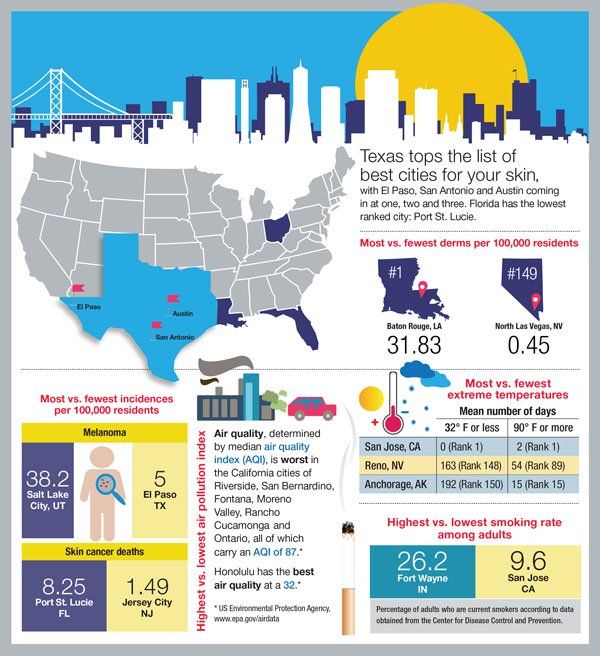- Case-Based Roundtable
- General Dermatology
- Eczema
- Chronic Hand Eczema
- Alopecia
- Aesthetics
- Vitiligo
- COVID-19
- Actinic Keratosis
- Precision Medicine and Biologics
- Rare Disease
- Wound Care
- Rosacea
- Psoriasis
- Psoriatic Arthritis
- Atopic Dermatitis
- Melasma
- NP and PA
- Skin Cancer
- Hidradenitis Suppurativa
- Drug Watch
- Pigmentary Disorders
- Acne
- Pediatric Dermatology
- Practice Management
- Prurigo Nodularis
- Buy-and-Bill
Article
Texas tops best cities for skin
The authors of a recent ranking scored cities according to 17 key metrics, including “melanoma incidence rate per 100,000 residents,” “ultraviolet index” and “number of days with extreme temperatures,” to “number of dermatologists.”This and more can be found on WalletHub’s analysis comparing 150 of the largest American cities.
Texas tops the list of best cities for your skin, with El Paso, San Antonio and Austin coming in at one, two and three;

Click the image to view it larger.
Source: https://wallethub.com/edu/best-cities-for-your-skin/20724/ while Florida ranks low as having among the worst cities for your skin, including the worst of the worst, Port St. Lucie.
This and more can be found on WalletHubâs analysis comparing 150 of the largest American cities: 2016 Best & Worst Cities for Your Skin.
The authors scored cities according to 17 key metrics, including âmelanoma incidence rate per 100,000 residents,â âultraviolet indexâ and ânumber of days with extreme temperatures,â to ânumber of dermatologists.â
Among the findings:
El Paso, Texas, has the fewest melanoma incidences per 100,000 residents, at five. Thatâs nearly eight time fewer than in Salt Lake City, the city with the most, 38.2.
Jersey City, N.J., has the lowest skin-cancer death rate per 100,000 residents, at 1.49. Port St. Lucie, Fla., has the highest, 8.25.
Air quality, determine by median air quality index, is worst in the California cities of Riverside, San Bernardino, Fontana, Moreno Valley, Rancho Cucamonga and Ontario. Honolulu, where the median index is about one-third that of the cities in California, has the best air quality.
Smoking rate among adults is lowest in San Jose, Calif., at 9.6 percent, which is nearly three times lower than in Fort Wayne, Ind., the city with the highest smoking rate, at 26.2 percent.
And while Baton Rouge, La., has 31.83 dermatologists per 100,000 residents, ranking it one for its high number of the skin specialists, North Las Vegas is the city with the lowest number of dermatologists, or 0.45 per 100,000 residents.
San Jose, Calif., has the fewest days of extreme temperatures, versus Reno, Nevada, which has the most.
Kira Minkis, M.D., Ph.D., a dermatologist at Weill Cornell Medicine and New York-Presbyterian, tells Dermatology Times that the information in the report is valuable to practicing dermatologists and their patients.
âThe methodology used to rank the cities was interesting and novel, taking into account not only sun exposure and UV rays, but other factors such as prevalence of skin cancers, pollution, smoking trends, accessibility to dermatologists. These are all important factors for us as dermatologists to be cognizant of, as well as to be able to educate our patients about skin health and skin cancer prophylaxis,â Dr. Minkis says. âI think every dermatologist educates their patients about the harmful effects of the sun and its contribution to skin cancer development. However some of these other factors--smoking cessation, avoidance of pollution, diet and water quality--are not as commonly counseled about and yet can play important roles in skin health.â
The reportâs findings arenât always what consumers might think. For example, sunny, warm states werenât always among the top in melanoma incidence.
Dr. Minkis, who is director of Mohs and dermatologic surgery at Weill Cornell Medicine, says that development of melanoma is very much multi-factorial.
âOf course sun exposure does tend to play a role. However, many other factors that are unaccounted for play an important role in melanoma development. Some of these other factors include family history and genetic predisposition to melanoma, skin typeâ¦,â she says. âCertain types of melanomas are more likely to be UV induced than others. Therefore, all of these factors must be taken into account and can explain why despite a high UV index, certain cities may have lower melanoma incidents than others.â
Disclosure: Dr Minkis has no conflicts of interest.



